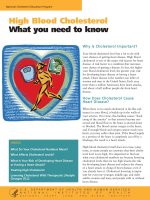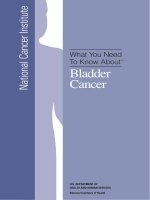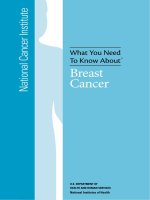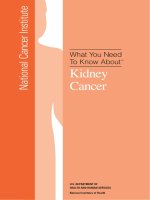Essential in oncologic imaging what radiologistes need to know
Bạn đang xem bản rút gọn của tài liệu. Xem và tải ngay bản đầy đủ của tài liệu tại đây (7.59 MB, 61 trang )
Essentials in Oncologic Imaging
What Radiologists Need to Know
Liver: Primary, Metastases
Richard Baron, M.D.
University of Chicago
Liver Malignancies
• Primary
– Hepatocellular Carcinoma (~85 – 90%)
– Cholangiocarcinoma (~5 – 10%)
– Rare tumors (Angiosarcoma, Lymphoma, Epithelioid
Hemangioendothelioma, others)
• Metastases
HCC without cirrhosis
Mosaic and capsule
HCC in Cirrhosis
• 10 – 14% of advanced cirrhosis harbors HCC
• 25% of Hepatitis B/C patients develop HCC within
•
10 years
Compare to risk of colon cancer in 50 y.o.:
< 1% prevalence, 7% lifetime incidence
Screening Cirrhosis: 1329 patients
Peterson et al, Radiology, 2000
Patients
Alcohol
B Hepatitis
C Hepatitis
B/C Hepatitis
C Hep/Alcohol
PBC
PSC
Other
%HCC
86
22
99
22
22
47
31
99
10%
27%
22%
18%
18%
2%
0%
8%
430
14% 59 pts
Screening Cirrhosis: 1329 patients
Peterson et al, Radiology, 2000
Patients
Alcohol
B Hepatitis
C Hepatitis
B/C Hepatitis
C Hep/Alcohol
PBC
PSC
Other
%HCC
86
22
99
22
22
47
31
99
10%
27%
22%
18%
18%
2%
0%
8%
430
14% 59 pts
Pathogenesis of HCC:
Key Role of Dysplastic Nodules
• Regenerative Nodule
• Large Regenerative Nodule
• Dysplastic Nodule
• HCC (nodule-in-nodule)
• HCC
Dysplastic Nodules: MR
CT: ~ 10% Lim et al, BJR 2004
MR: 10 – 15% Krinsky, Radiology 2001
Dysplastic Nodules:
Low Grade
- Nuclear atypia is minimal
- Portal tracts present
High Grade
- High nuclear cytoplasmic ratio
- Rare mitotic figures
- Resistance to iron accumulation
-New vessels (nontriadal arteries) increase
-Portal flow to nodules decreases
HCC
AP
PV
HCC: Detection
Patient
Detection
Lesion
Detection
Study
CT
67 – 73%
35%
Peterson, 2000
MR
77%
37%
Krinsky, 2001
91%
Bhartia, 2003
MR
Dual Contrast
US
~ 50%
~ 35%
multiple
48 y.o. male, chronic hepatitis C
Solitary 2.5 cm lesion
AP
PV
EQ
What would be next best step
To plan appropriate treatment?
A. Biopsy Lesion
B. Confirm with MR exam
C. Make Rx plans as HCC
D. F/U imaging in 3 - 6 mos.
HCC Dx: 2005 AASLD CRITERIA
> 20 mm Liver Lesion, chronic liver disease
One imaging technique with typical HCC
AP
(AP hypervascularity & EQ washout)
One imaging technique showing a mass with
AFP levels > 200 ng/ml
10-20 mm
Two imaging techniques with
typical HCC (AP hypervascularity & washout
< 10 mm
PV
Repeat US every 3-6 months for 2 yrs
American Association for the Study of Liver Diseases
(AASLD) Practice Guideline. Hepatology 2005;42:1208
EQ
HCC Dx: 2010 AASLD CRITERIA
> 10 mm Liver Lesion, chronic liver disease
One imaging technique with typical HCC
AP
(AP hypervascularity & EQ washout)
< 10 mm
Repeat US every 3-6 months for 2 years
American Association for the Study of Liver Diseases (AASLD)
Practice Guideline. Bruix and Sherman. Hepatology 2010
PV
EQ
Why is non biopsy Dx important?
2009
2011
01/22/2008
Pre
10/30/2007
Value of Equilibrium Phase CT
Early arterial
Late arterial
Portal
Equilibrium
Courtesy of M. Hori , Osaka
‘Peliotic HCC’
T1
AP
AP
PV
T2
PV
EQ
2 hr
AP
PV
EQ
Small (10-20 mm) Enhancing CT/MR Nodules
• O’Malley et al (Am J. Gastro 2005): 28% HCC
– Doubling time – 6 mos.
• Jeong et al (AJR, 2002):
13% HCC
• Most small enhancing nodules are not HCC
• Delay, washout characteristics helpful in characterizing
• Multimodality imaging & Follow-up imaging essential
HCC: MRI signal intensities
AP
EQ
Delay
T1
T2
DWI
Enhancing Nodule: Value of T2 characteristics
AP
EQ
OP T1
F/U OP T1
2007 f/u 2007
IP T1
OP T1
2008
“Nodule
in
Nodule”
Evolution
Evolution Dysplastic Nodule to HCC
2005
T2
2006
2007
T1









